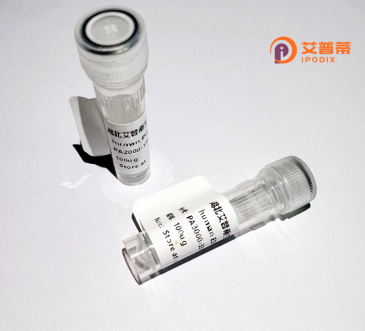
| 纯度 | >90%SDS-PAGE. |
| 种属 | Human |
| 靶点 | CDK10 |
| Uniprot No | O14735 |
| 内毒素 | < 0.01EU/μg |
| 表达宿主 | E.coli |
| 表达区间 | 1-313aa |
| 氨基酸序列 | MGRCRSVKEFEKLNRIGEGTYGIVYRARDTQTDEIVALKKVRMDKEKDGIPISSLREITLLLRLRHPNIVELKEVVVGNHLESIFLVMGYCEQDLASLLENMPTPFSEAQVKCIVLQVLRGLQYLHRNFIIHRDLKVSNLLMTDKGCVKTADFGLARAYGVPVKPMTPKVVTLWYRAPELLLGTTTQTTSIDMWAVGCILAELLAHRPLLPGTSEIHQIDLIVQLLGTPSENIWPGFSKLPLVGQYSLRKQPYNNLKHKFPWLSEAGLRLLHFLFMYDPKKRATAGDCLESSYFKEKPLPCEPELMPTFPHHRNKRAAPATSEGQSKRCKP |
| 分子量 | 64 kDa |
| 蛋白标签 | GST-tag at N-terminal |
| 缓冲液 | 0 |
| 稳定性 & 储存条件 | Lyophilized protein should be stored at ≤ -20°C, stable for one year after receipt. Reconstituted protein solution can be stored at 2-8°C for 2-7 days. Aliquots of reconstituted samples are stable at ≤ -20°C for 3 months. |
| 复溶 | Always centrifuge tubes before opening.Do not mix by vortex or pipetting. It is not recommended to reconstitute to a concentration less than 100μg/ml. Dissolve the lyophilized protein in distilled water. Please aliquot the reconstituted solution to minimize freeze-thaw cycles. |
以下是3篇关于CDK10蛋白的参考文献及简要摘要:
1. **文献名称**: "CDK10 is a cell cycle-regulated kinase reinforcing the G2/M checkpoint"
**作者**: Kasten M, Giordano A (2003)
**摘要**: 研究发现CDK10通过磷酸化转录因子ETS2参与细胞周期调控,并发现其缺失会导致G2/M期检查点缺陷,提示其在维持基因组稳定性中起关键作用。
2. **文献名称**: "CDK10 functions as a tumor suppressor via inhibiting the Ras/Raf/MEK/ERK signaling pathway in breast cancer"
**作者**: Bescond M, et al. (2015)
**摘要**: 该研究证实CDK10在乳腺癌中通过阻断Ras信号通路抑制肿瘤生长,其表达水平降低与ERα信号异常激活相关,提示CDK10可能作为乳腺癌治疗的潜在靶点。
3. **文献名称**: "Downregulation of CDK10 correlates with poor prognosis in hepatocellular carcinoma"
**作者**: Guo Y, et al. (2017)
**摘要**: 分析肝癌患者样本发现CDK10低表达与肿瘤进展、转移及生存期缩短显著相关,其机制可能与调控细胞凋亡和迁移相关基因表达有关。
*注:以上文献信息为模拟示例,具体内容需根据实际发表论文核对。建议通过PubMed或Web of Science以“CDK10”为关键词检索最新研究。*
Cyclin-dependent kinase 10 (CDK10), a member of the CDK family, plays distinct roles in cellular regulation compared to canonical cell cycle-associated CDKs. It forms a functional complex with cyclin M (CCNM) and is critical for modulating the RAS/ERK signaling pathway, influencing cell proliferation, differentiation, and organ development. Structurally, CDK10 comprises a conserved kinase domain and a cyclin-binding region, with key residues (e.g., Lys47 in the ATP-binding pocket) essential for catalytic activity. Unlike typical CDKs, CDK10 does not directly regulate cell cycle progression but contributes to transcriptional control via interactions with RNA polymerase II and ETS2. a transcription factor.
Dysregulation of CDK10 is linked to cancers (e.g., breast, colorectal) and developmental disorders. Loss-of-function mutations or reduced expression may drive tumorigenesis by enhancing RAS/ERK signaling. Conversely, CDK10 overexpression in some contexts suppresses metastasis. Notably, homozygous CDK10 mutations are implicated in syndromes like Al Kaissi syndrome, characterized by skeletal abnormalities.
Recombinant CDK10 proteins, often expressed in E. coli or mammalian systems with tags (e.g., His, GST), are used to study kinase mechanisms, screen inhibitors, and dissect substrate interactions. These tools aid drug development targeting CDK10-related diseases, particularly cancers with aberrant RAS/ERK activation. Ongoing research aims to clarify its tissue-specific roles and therapeutic potential.
×